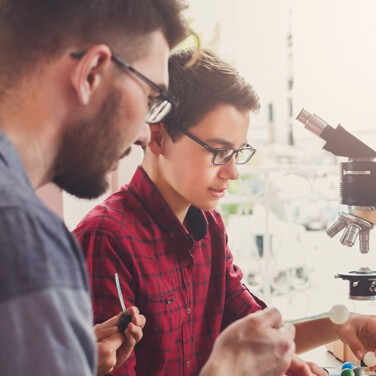Cell-Free Gene Editing: Just Add Water
By Gina Wynn
Scientists at Northwestern University have developed a practical and economical new generation of hands-on teaching tools to inspire the next generation of synthetic biologists. As a pilot study, they supplied Chicago-area teachers and high school students with BioBits Health educational kits for conducting normally complex biological experiments that produce results within a few hours.
The classroom-based interactive lab projects require students to simply add water and reagents to freeze-dried cell material in test tubes. The reactions involve proteins that produce fluorescence that enables students to see results quickly and easily.
“We have linked … abstract, really advanced biological concept[s] to the presence or absence of a fluorescent protein,” said Jessica Stark, graduate student and leader of the BioBits Health research team. “It’s something students can see, something they can visually understand.”
Breakthrough Biology
BioBits kits include experimental modules and supplementary materials to help young scientists explore scientific research strategies ethically, cost-effectively, and safely. Michael Jewett, Ph.D., professor of chemical and biological engineering and the study’s principal investigator, has been influential in developing ethical methods of harnessing biological systems without using living cells. He is also co-director of Northwestern’s Center for Synthetic Biology.
Working with living cells also requires expensive equipment, and it’s time-consuming to keep cells alive and contained for an extended period of time. That’s why Jewett’s team — made up of researchers from Northwestern University and MIT — included non-living components in the BioBits experimental modules. The components are made of extracted cell structures that have been freeze dried for shelf stability.
“These are essentially test-tube biological reactions,” said Stark, a National Science Foundation graduate research fellow. “We break the cells open and use their guts, which still contain all of the necessary biological machinery to carry out a reaction. We no longer need living cells to demonstrate biology.”
Classrooms on the Cutting Edge
Since the launch of the BioBits program in the summer of 2018, Jewett and his team have expanded the focus of their kits to tackle two current topics that are important for society: antibiotic resistance and gene editing. The journal ACS Synthetic Biology reported on the BioBits Health pilot study and the kit enhancements.
Jewett and Stark were motivated by recent predictions that infections from drug-resistant bacteria will kill 10 million people a year worldwide by 2050 — more than currently die from cancer.
They developed an experimental module where students run two sets of reactions: one set contains an antibiotic-resistant gene and one set does not. When students add an antibiotic, the test tube will glow if a fluorescent protein was produced. This indicates that the organism is resistant to the antibiotic. If it does not glow, then the antibiotic is effective.
“Because we’re using cell-free systems rather than organisms, we can demonstrate drug resistance in a way that doesn’t create drug-resistant bacteria,” Stark explained. “We can demonstrate these concepts without the risks.”
CRISPR Conversations
Jewett’s team also developed experimental gene editing modules that harness Clustered Regularly Interspaced Short Palindromic Repeats (CRISPR) technology. One of the most significant scientific breakthroughs of the past decade, CRISPR turns off or edits targeted genes by using enzymes to cut DNA strands in specific locations.
According to the Northwestern University website, the new BioBits kits contain the three essential CRISPR components: an enzyme called the Cas9 protein, a target DNA sequence encoding a fluorescent protein, and an RNA molecule that targets the fluorescent protein gene. When students add all three components and water to the freeze-dried cell-free test tube contents, it starts a reaction that edits the DNA that codes for the fluorescent protein. If the DNA is successfully edited, the materials do not glow. If the DNA is not edited, fluorescent protein is made and the tube illuminates.
“There is a lot of excitement about being able to edit genomes with these technologies,” Jewett said. “BioBits Health calls attention to a lot of important questions — not only about how CRISPR technology works but about ethics that society should be thinking about. We hope that this promotes a conversation and dialogue about such technologies.”
